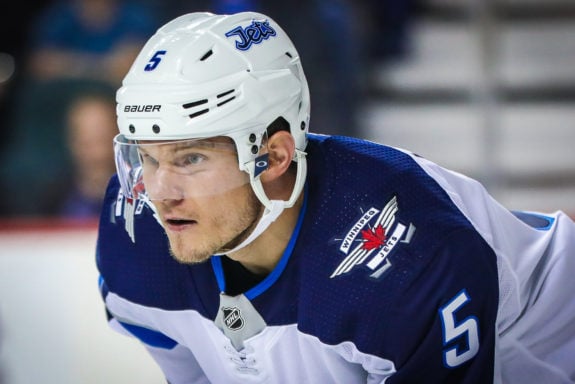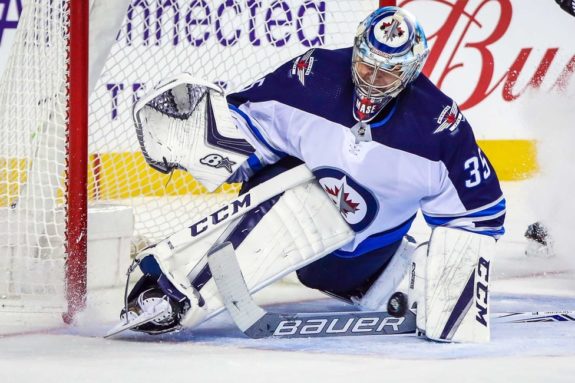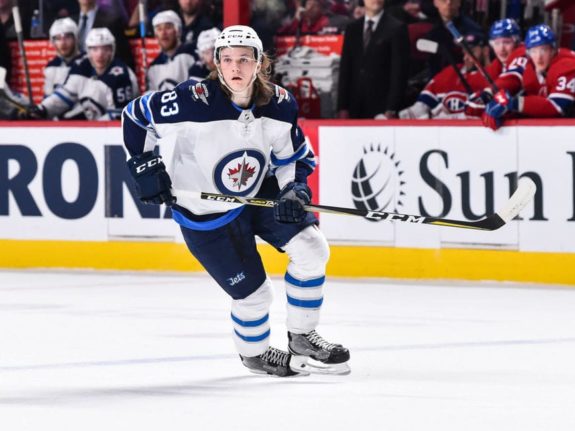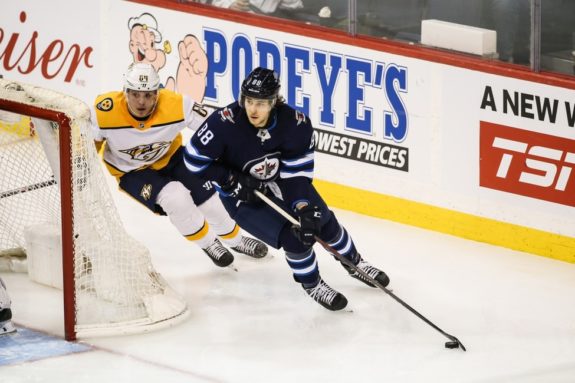The Winnipeg Jets have quite the to-do list in what is an integral offseason for a team that made a disappointing first-round exit in the Stanley Cup Playoffs last month.
One of the items on that list should be to solve their Kulikov conundrum.
Kulikov Contract is the Jets’ Worst
Of all the team-friendly contracts Jets general manager Kevin Cheveldayoff has inked — Mark Scheifele at $6.15 million annually over eight years and Nikolaj Ehlers at $6 million annually over seven, to name just two — Dmitry Kulikov’s contract is decidedly not one of them.

The Jets have not gotten good value from the three-year, $13-million contract they signed the then-26-year-old defenseman toback on Free Agent Frenzy Day in 2017.
There was hope Kulikov could fulfill a top-four role, but it hasn’t worked out that way. Over the past two seasons, the left-handed Russian’s been relegated to a third-pairing role.
In his two seasons in Winnipeg, Kulikov has never come close to matching the offensive output he provided to the Florida Panthers for seven seasons between 2009 and 2016. He has 138 career points, but only 17 of them have come in a Jets jersey, and he didn’t even score a goal in 2018-19.
That wouldn’t be such a problem — given the Jets’ offensive firepower — if he’d been a stalwart and dependable blueliner, but he’s been neither. Kulikov has missed 45 games due to injuries in his Jets tenure and has been near the bottom when it comes to Corsi, Fenwick, and other advanced metrics.
It’s clear his numbers and average 2018-19 ice-time of 15:40 are unacceptable for someone making nearly $4.5 million.
Buyout or Trade Should Both Be Considered
It’s time the Jets either buy Kulikov out or ship him off to rid themselves of his detrimental contract.
Buyouts are complicated, but here’s they work in a nutshell:
“Teams are permitted to buyout a players contract to obtain a reduced salary cap hit over a period of twice the remaining length of the contract,” CapFriendly writes in their Buyout FAQ.
“The buyout amount is a function of the players age at the time of the buyout, and are as follows: 1/3 of the remaining contract value, if the player is younger than 26 at the time of the buyout, (or) 2/3 of the remaining contract value, if the player is 26 or older at the time of the buyout.”

Kulikov would be eligible for the latter, as he’s 28, meaning the Jets would owe him $2.888 million. However, since the cap hit takes place over “a period of twice the remaining length of contract” — in this case, that period would be two years — the Jets would owe Kulikov $1.444 million in 2019-20 and then another $1.444 million in 2020-21.
A buyout this summer would free up $2.888 million of 2019-20 cap space, which would be quite helpful given the number of restricted and unrestricted free agents they have: Kyle Connor and Patrik Laine being among them.
A buyout would actually cost the Jets $1.444 million come 2020-21, a hit that would be worthwhile to take if it allows a prospect to get more playing time (we’ll explore that in just a few paragraphs.)
An “addition by subtraction” salary-dump trade is also a possibility — a trade where getting a player off the books is more important than the player received in return. However, the Jets would have to sweeten any Kulikov deal by parting with someone desirable in order to convince a suitor to take on his contract.
They did that last June, when they ditched Steve Mason’s problematic contract and freed up $4.1 million by trading the oft-injured goaltender to the Montreal Canadiens along with Joel Armia and two draft picks as sweeteners.

Possible sweeteners in a Kulikov deal could include draft picks, a bottom-six forward, or a prospect such as Michael Spacek or Logan Stanley. It really depends on the needs of the trade partner.
Keeping Kulikov Stands in the Way of Development
Having Kulikov take up a space on the blue line for another season would mean he’d be occupying a spot at the expense of the development of someone younger and in the Jets’ future plans.
The person who would benefit most from Kulikov’s departure would be Sami Niku.
The 22-year-old Finn suited up for 30 games for the Jets this season after being named the AHL’s most outstanding defenseman in his 2017-18 rookie season to remember. While his play showed his inexperience, it also showed promise.

However, Niku spent too much time in the press box and was a healthy scratch for the last five regular season games and all six playoff games.
The fact the Jets left Niku off the Manitoba Moose playoff roster indicate he’s never going back to the AHL; he won’t develop if he only plays 30 games next season because Kulikov’s taking his spot.
Another left-handed defenseman who could factor into the conversation is Nathan Beaulieu, who the Jets acquired from the Buffalo Sabres at the trade deadline. The Jets leaned heavily on the 26-year-old in March, as he was immediately given a top-pairing role alongside Jacob Trouba, replacing the injured Josh Morrissey.

Beaulieu is statistically not a shut-down defender, but is a strong transition player who carries the puck well. He showed fairly well in 18 games before being sent to the press box upon Morrissey’s return, tallying five assists.
Beaulieu’s two-year contract — which saw him make $2.4 million annually — is up, so the Jets would have to ink him to a new deal. It’s a possibility he re-signs as the Jets’ d-corp is in flux — Tyler Myers and Ben Chiarot are both UFAs that are due raises and Jacob Trouba will likely be traded — but it’s by no means a foregone conclusion Beaulieu will be a Jet come fall.
The Time is Now
Kulikov is not in the Jets’ long-term plans, so they might as well get a one-year head start in paving the way for someone who is. Given Kulikov’s limited impact and ugly numbers, it’s likely whoever replaces him will be an upgrade anyway.
While, at first glance, clearing out Kulikov doesn’t seem like a top priority given all the Jets have to do between now and September, it’s clear solving this conundrum is important for the present and the future.